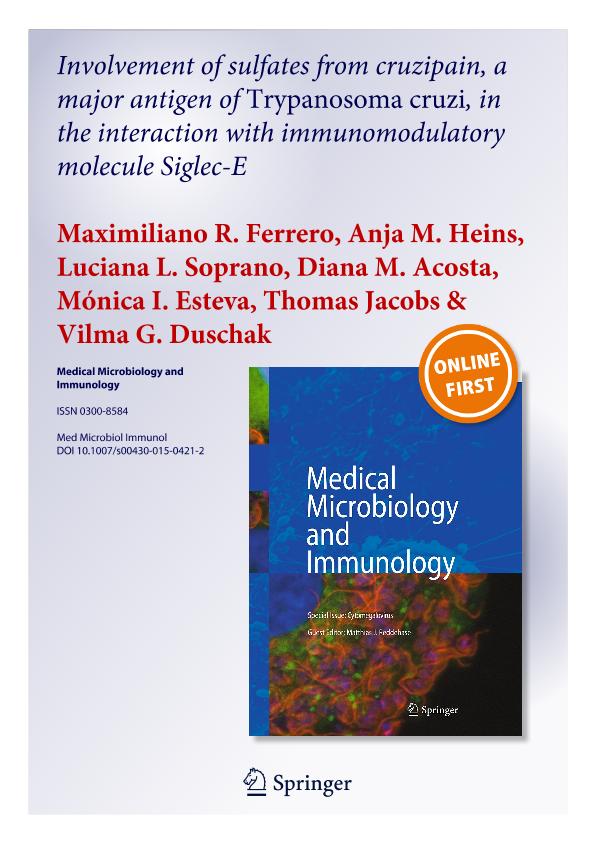Mostrar el registro sencillo del ítem
dc.contributor.author
Ferrero, Maximiliano Ruben

dc.contributor.author
Heins, Anja M.
dc.contributor.author
Soprano, Luciana Lía

dc.contributor.author
Acosta, Diana Maria

dc.contributor.author
Esteva, Mónica Inés

dc.contributor.author
Jacobs, Thomas
dc.contributor.author
Duschak, Vilma Gladys

dc.date.available
2018-04-10T20:55:11Z
dc.date.issued
2015-06
dc.identifier.citation
Ferrero, Maximiliano Ruben; Heins, Anja M.; Soprano, Luciana Lía; Acosta, Diana Maria; Esteva, Mónica Inés; et al.; Involvement of sulfates from cruzipain, a major antigen of Trypanosoma cruzi, in the interaction with immunomodulatory molecule Siglec-E; Springer; Medical Microbiology and Immunology; 205; 1; 6-2015; 21-35
dc.identifier.issn
0300-8584
dc.identifier.uri
http://hdl.handle.net/11336/41641
dc.description.abstract
In order to investigate the involvement of sulfated groups in the Trypanosoma cruzi host–parasite relationship, we studied the interaction between the major cysteine proteinase of T. cruzi, cruzipain (Cz), a sulfate-containing sialylated molecule and the sialic acid-binding immunoglobulin like lectin-E (Siglec-E). To this aim, ELISA, indirect immunofluorescence assays and flow cytometry, using mouse Siglec-E–Fc fusion molecules and glycoproteins of parasites, were performed. Competition assays verified that the lectins, Maackia amurensis II (Mal II) and Siglec-E–Fc, compete for the same binding sites. Taking into account that Mal II binding remains unaltered by sulfation, we established this lectin as sialylation degree control. Proteins of an enriched microsomal fraction showed the highest binding to Siglec-E as compared with those from the other parasite subcellular fractions. ELISA assays and the affinity purification of Cz by a Siglec-E column confirmed the interaction between both molecules. The significant decrease in binding of Siglec-E–Fc to Cz and to its C-terminal domain (C-T) after desulfation of these molecules suggests that sulfates contribute to the interaction between Siglec-E–Fc and these glycoproteins. Competitive ELISA assays confirmed the involvement of sulfated epitopes in the affinity between Siglec-E and Cz, probably modified by natural protein environment. Interestingly, data from flow cytometry of untreated and chlorate-treated parasites suggested that sulfates are not primary receptors, but enhance the binding of Siglec-E to trypomastigotic forms. Altogether, our findings support the notion that sulfate-containing sialylated glycoproteins interact with Siglec-E, an ortholog protein of human Siglec-9, and might modulate the immune response of the host, favoring parasitemia and persistence of the parasite.
dc.format
application/pdf
dc.language.iso
eng
dc.publisher
Springer

dc.rights
info:eu-repo/semantics/openAccess
dc.rights.uri
https://creativecommons.org/licenses/by-nc-sa/2.5/ar/
dc.subject
Trypanosoma Cruzi
dc.subject
Cruzipain
dc.subject
Sulfates
dc.subject
Siglec-E
dc.subject.classification
Salud Ocupacional

dc.subject.classification
Ciencias de la Salud

dc.subject.classification
CIENCIAS MÉDICAS Y DE LA SALUD

dc.title
Involvement of sulfates from cruzipain, a major antigen of Trypanosoma cruzi, in the interaction with immunomodulatory molecule Siglec-E
dc.type
info:eu-repo/semantics/article
dc.type
info:ar-repo/semantics/artículo
dc.type
info:eu-repo/semantics/publishedVersion
dc.date.updated
2018-04-10T14:17:01Z
dc.journal.volume
205
dc.journal.number
1
dc.journal.pagination
21-35
dc.journal.pais
Alemania

dc.journal.ciudad
Berlín
dc.description.fil
Fil: Ferrero, Maximiliano Ruben. Dirección Nacional de Instituto de Investigación. Administración Nacional de Laboratorio e Instituto de Salud “Dr. C. G. Malbrán”. Instituto Nacional de Parasitología ; Argentina. Consejo Nacional de Investigaciones Científicas y Técnicas; Argentina
dc.description.fil
Fil: Heins, Anja M.. Bernhard Nocht Institute for Tropical Medicine; Alemania
dc.description.fil
Fil: Soprano, Luciana Lía. Dirección Nacional de Instituto de Investigación. Administración Nacional de Laboratorio e Instituto de Salud “Dr. C. G. Malbrán”. Instituto Nacional de Parasitología ; Argentina. Consejo Nacional de Investigaciones Científicas y Técnicas; Argentina
dc.description.fil
Fil: Acosta, Diana Maria. Dirección Nacional de Instituto de Investigación. Administración Nacional de Laboratorio e Instituto de Salud “Dr. C. G. Malbrán”. Instituto Nacional de Parasitología ; Argentina. Consejo Nacional de Investigaciones Científicas y Técnicas; Argentina
dc.description.fil
Fil: Esteva, Mónica Inés. Dirección Nacional de Instituto de Investigación. Administración Nacional de Laboratorio e Instituto de Salud “Dr. C. G. Malbrán”. Instituto Nacional de Parasitología ; Argentina. Consejo Nacional de Investigaciones Científicas y Técnicas; Argentina
dc.description.fil
Fil: Jacobs, Thomas. Bernhard Nocht Institute for Tropical Medicine; Alemania
dc.description.fil
Fil: Duschak, Vilma Gladys. Dirección Nacional de Instituto de Investigación. Administración Nacional de Laboratorio e Instituto de Salud “Dr. C. G. Malbrán”. Instituto Nacional de Parasitología ; Argentina. Consejo Nacional de Investigaciones Científicas y Técnicas; Argentina
dc.journal.title
Medical Microbiology and Immunology

dc.relation.alternativeid
info:eu-repo/semantics/altIdentifier/doi/http://doi.org/10.1007/s00430-015-0421-2
dc.relation.alternativeid
info:eu-repo/semantics/altIdentifier/url/https://link.springer.com/article/10.1007%2Fs00430-015-0421-2
Archivos asociados
